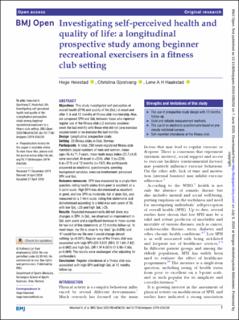Investigating self-perceived health and quality of life: A longitudinal prospective study among beginner recreational exercisers in a fitness club setting
Peer reviewed, Journal article
Published version
Permanent lenke
https://hdl.handle.net/11250/2663632Utgivelsesdato
2020Metadata
Vis full innførselSamlinger
- Artikler / Articles [2119]
- Publikasjoner fra Cristin [1107]
Sammendrag
Objectives: This study investigated self-perception of overall health (SPH) and quality of life (QoL) at onset and after 3, 6 and 12 months of fitness club membership. Also, we compared SPH and QoL between those who reported regular use of the fitness club (≥2 exercise sessions/week the last month) with those who did not (one exercise session/week or no exercise the last month). Design: Longitudinal prospective study. Setting: 25 fitness clubs in Oslo, Norway. Participants: In total, 250 newly registered fitness club members (equal numbers of men and women, mean age=36.4±11.3 years, mean body mass index=25.7±4.4) were recruited. At onset (n=250), after 3 (n=224), 6 (n=213) and 12 months (n=187), the participants answered an electronic questionnaire, covering background variables, exercise involvement, perceived SPH and QoL. Outcome measures: SPH was measured by a single-item question, rating health status from poor to excellent on a 5-point scale. High SPH was dichotomised as excellent or good, and low SPH as moderate, fair or poor. QoL was measured on a 7-item scale, rating five statements and dichotomised according to a total max sum score of 35, with low QoL ≤25 and high QoL >25. Results: Repeated measurements did not show any changes in SPH. In QoL, we observed an improvement in QoL sum score and a significant increase in mean scores for two out of five statements at 12 months follow-up: ‘In most ways, my life is close to my ideal’ (p=0.036) and ‘If I could live my life over, I would change almost nothing’ (p<0.001). Regular use of the fitness club was associated with high SPH (OR 3.532 (95% CI 1.60–7.82), p=0.002) and high QoL (OR 1.914 (95% CI 0.95–3.86), p=0.069). The results were unchanged after adjusting for confounders. Conclusion: Regular attendance at a fitness club was associated with high SPH and high QoL at 12 months follow-up.
Beskrivelse
Re-use permitted under CC BY-NC. No commercial re-use. See rights and permissions. Published by BMJ.
